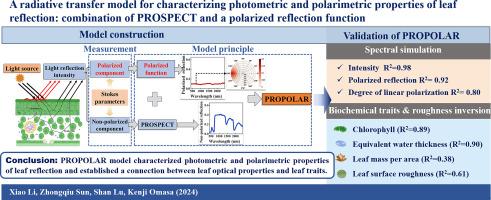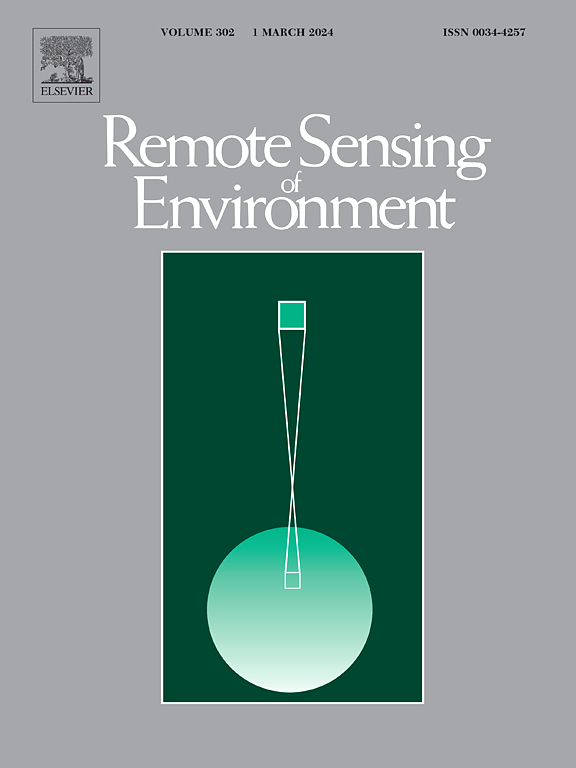A radiative transfer model for characterizing photometric and polarimetric properties of leaf reflection: Combination of PROSPECT and a polarized reflection function
IF 11.1
1区 地球科学
Q1 ENVIRONMENTAL SCIENCES
引用次数: 0
Abstract
Light photometric and polarimetric characteristics are crucial for describing the optical properties of leaf reflections, which play an essential role in investigating biochemical and surface structural trait inversion and radiative balance between vegetation and atmospheric system. Although several physical models are available, research on a comprehensive model that accounts for both photometric and polarimetric characteristics and incorporates biochemical and surface structural traits is still inadequate. In this study, we introduced PROPOLAR, a leaf model that considered leaf reflection in terms of polarized and unpolarized components and linked leaf reflection to leaf traits. PROPOLAR employed PROSPECT to simulate non-polarized component associated with biochemical traits, while used a three-parameter function (linear coefficient, refractive index factor, and roughness of leaf surface) to simulate the polarized component. The model was validated using a dataset (composed of both photometric and polarimetric measurements) collected from 533 samples of 13 plant species under various illumination-viewing geometries. The results showed that PROPOLAR outperformed PROSPECT and PROSPECULAR (a leaf model charactering BRF) in simulating light intensity (R2 = 0.98), and effectively simulated bidirectional polarization reflectance factor (BPRF) and degree of linear polarization (Dolp) across a wide spectral range (450–2300 nm) and species, with R2 = 0.92, and 0.80, respectively. Furthermore, PROPOLAR enhanced the accuracy of PROSPECT and showed comparable accuracy with PROSPECULAR in the inversion of biochemical traits from the multi-angular polarization measurements, including chlorophyll (R2 = 0.89, RMSE = 12.83 μg/cm2), equivalent water thickness (R2 = 0.90, RMSE = 0.0032 g/cm2), and leaf mass per area (R2 = 0.38, RMSE = 0.0031 g/cm2), due to the incorporation of polarization reflection and a linear coefficient during calibration. Notably, PROPOLAR can invert roughness and showed reasonable consistency with measured roughness (R2 = 0.61). These results demonstrated the effectiveness of PROPOLAR in simulating both photometric and polarimetric properties of leaf reflection, as well as its potential for biochemical and surface structural trait inversion. PROPOLAR may advance remote sensing applications in vegetation management by integrating photometric and polarimetric properties.


表征叶片反射光度和偏振特性的辐射传输模型:PROSPECT和偏振反射函数的组合
光的光度和偏振特性是描述叶片反射光学特性的关键,在研究植被与大气系统的生物化学和表面结构特征反演以及辐射平衡等方面发挥着重要作用。虽然有几种物理模型可用,但考虑到光度和极化特征并结合生化和表面结构特征的综合模型的研究仍然不足。在本研究中,我们引入了PROPOLAR叶片模型,该模型考虑了叶片反射的极化和非极化分量,并将叶片反射与叶片性状联系起来。PROPOLAR采用PROSPECT模拟与生化性状相关的非极化成分,采用线性系数、折射率因子和叶片表面粗糙度三参数函数模拟极化成分。该模型使用从13种植物的533个样品中收集的数据集(由光度和偏振测量组成)在不同的照明观测几何形状下进行验证。结果表明,PROPOLAR在模拟光强方面优于PROSPECT和PROSPECULAR(表征BRF的叶片模型)(R2 = 0.98),在较宽光谱范围(450 ~ 2300 nm)和物种范围内有效模拟双向偏振反射因子(BPRF)和线性偏振度(Dolp), R2分别为0.92和0.80。此外,由于在校正过程中加入了偏振反射和线性系数,PROPOLAR提高了PROSPECT的精度,在多角度偏振测量的生化性状反演中,包括叶绿素(R2 = 0.89, RMSE = 12.83 μg/cm2)、等效水厚度(R2 = 0.90, RMSE = 0.0032 g/cm2)和每面积叶质量(R2 = 0.38, RMSE = 0.0031 g/cm2),其精度与PROSPECULAR相当。值得注意的是,PROPOLAR可以反演粗糙度,并且与实测粗糙度具有合理的一致性(R2 = 0.61)。这些结果证明了PROPOLAR在模拟叶片反射的光度和偏振特性方面的有效性,以及它在生化和表面结构特征反演方面的潜力。PROPOLAR可以通过整合光度和偏振特性来推进遥感在植被管理中的应用。
本文章由计算机程序翻译,如有差异,请以英文原文为准。
求助全文
约1分钟内获得全文
求助全文
来源期刊

Remote Sensing of Environment
环境科学-成像科学与照相技术
CiteScore
25.10
自引率
8.90%
发文量
455
审稿时长
53 days
期刊介绍:
Remote Sensing of Environment (RSE) serves the Earth observation community by disseminating results on the theory, science, applications, and technology that contribute to advancing the field of remote sensing. With a thoroughly interdisciplinary approach, RSE encompasses terrestrial, oceanic, and atmospheric sensing.
The journal emphasizes biophysical and quantitative approaches to remote sensing at local to global scales, covering a diverse range of applications and techniques.
RSE serves as a vital platform for the exchange of knowledge and advancements in the dynamic field of remote sensing.
 求助内容:
求助内容: 应助结果提醒方式:
应助结果提醒方式:


